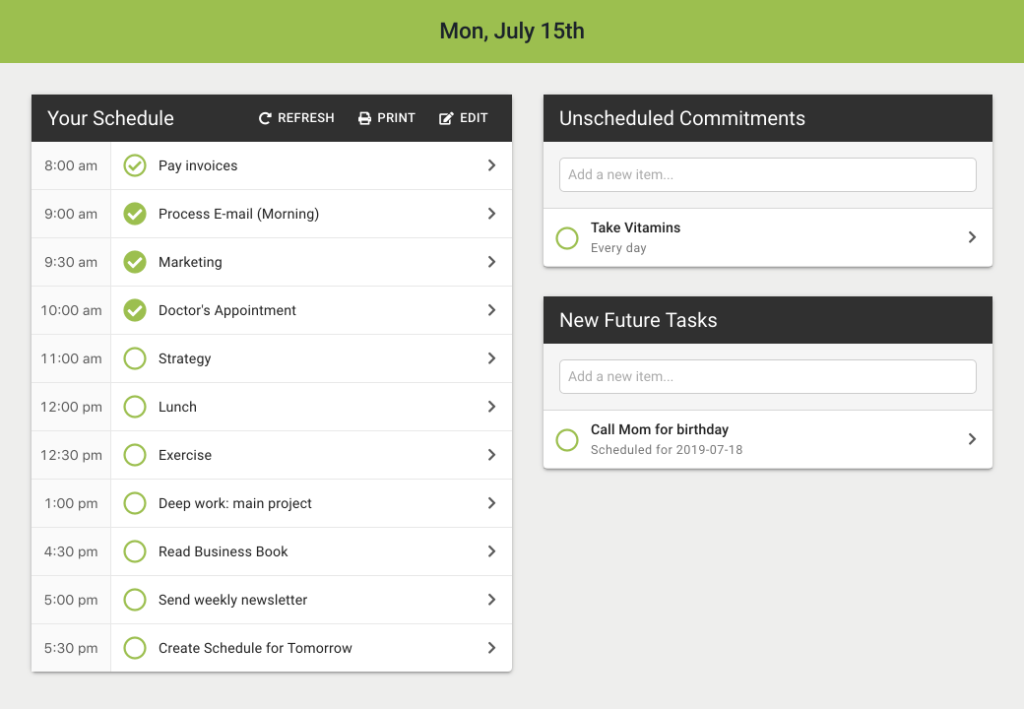What if you could improve the speed and quality of your work by structuring your tasks to optimize your thought processes?
As knowledge workers, our capacity for work lies in our brains. Most productivity advice for knowledge workers centers around how we can improve that capacity by increasing our focus, reducing distractions, eliminating interruptions, etc.
One aspect that is often overlooked is how we think—or rather, the ways we employ our brains to accomplish certain tasks or sub-tasks.
Today I’m going to introduce you to the concept of a “mental mode” 1 and then teach you how you can use this concept to structure your work to optimize how you think.
What is a Mental Mode?
A mental mode is the way your brain activates for a specific type of task or sub-task. A mental mode has three parts:
- Thinking Mode
The way you think. Concepts like convergent vs divergent thinking, focused vs diffuse thinking, the OODA loop (Observe – Orient – Decide – Act) and others reflect ways of categorizing these thinking modes. Each provides a useful lens, but in relation to mental modes, they are all ways of thinking. - Perception Mode
How you take in information and sensations. Are you noticing the details or seeing the patterns those details create? How much do you perceive your periphery vision and sensations? Perception can be influenced by thinking, but comes before it—what your brain filters out isn’t available for processing. - Memory Activation
The information you actively have available to you to use in your thinking. This is the information you can quickly access to use in your thinking and includes both new information coming from your senses and existing information encoded in various forms of memory. 2
Different tasks and subtasks often require different mental modes, and as you move through these you’ll need to change one or more of these aspects to switch into a new mental mode.
Example Mental Modes
The concept of mental modes can be pretty abstract, so let’s look at a concrete example that better explains the concept.
Imagine you have a long-form writing task. It could be a blog post, an essay, a book or an article. Within this task, you have (at least) three different subtasks:
- Plan: Decide what you will be writing about and how to structure the piece.
- Write: Write the words and sentences that compose the content of the piece.
- Edit: Review what you have written and make changes or corrections.
Each of these different subtasks require different mental modes. For example:
- Planning may require a brainstorming thinking mode where you attempt to come up with ideas for the topic or how to break that topic down. During planning, your perception often expands—for instance by looking at your entire outline rather than a single line—and your memory contains all of the background information related to what you plan to write.
- Writing may require a literary/auditory thinking mode where you speak in your head what you are about to write, hearing how it flows before you write or type out your words. During the writing phase, your perception often narrows to the sentence or paragraph you are working on, while your memory retains activation of the background information needed for your writing.
- Editing may require an analytical thinking mode where you read and evaluate whether what you’ve written is grammatically correct and has proper punctuation. Perception during this phase may narrow down to specific words or punctuation, while your memory switches to helping you retain different parts of your piece so you can ensure coherence and flow.
Don’t get too caught up in breaking each mode down into thinking, perception and memory though. Using the concept of memory modes effectively relies not on their component parts, but the broader concept of our brains activating in different ways for different types of tasks or subtasks.
For example, while it can be useful to consider that editing requires an analytical thinking mode, I find it more useful to say I’m in an “editing” mental mode. This better reflects the interplay of the different components of mental modes and makes it easier to identify one as related to the type of task I am working on.
Using Mental Modes to Optimize Thinking
Now that we understand what a mental mode is, how can we use the concept of mental modes to optimize our thinking?
Before diving into the the strategies, let’s look at a few ideas:
- Mental Mode Switching
When we switch between different tasks or subtasks, we may need to switch into a new mental mode. This may require loading new information into our memory and changing the way our brain perceives and thinks. - Cost of Mode-Switching
Similar to task switching while multi-tasking, we incur a cost when mode-switching. However, even a single task may require switching between mental modes, so we may incur this cost even if we are single-tasking. - Clusters of Mental Modes
Mental modes often overlap to some degree. When we switch between them, switching to a mental mode radically different than our current one incurs a greater mental cost than switching to a related mental mode. - Biology of Mental Modes
Our internal biological cycles can support or hinder specific mental modes. Research into circadian rhythms points to early birds doing better with analytical thinking in the morning and creative thinking in the afternoon, and our capacity to perceive and use our memory can change during the day.
Based on these ideas, there are three strategies we can use to optimize our thinking and improve our productivity by using the concept of mental modes.
1. Minimize Mode-Switching During Tasks
Structure your work on a task to minimize mode-switching whenever possible.
Staying in the same mental mode for longer improves not only the efficiency, but the quality of our work. Constantly loading and unloading our memory when switching between mental modes can cause us to miss information that would otherwise be available if we stayed in the same mode.
This is a key principle behind the CASE (Commit – Allocate – Schedule – Evaluate) planning method upon which Day Optimizer is based on.
When planning your day, rather than taking one task at a time to commit to, allocate time to and schedule—which requires constantly switching between different mental modes—decide everything you want to work on in a single step, then in a separate step allocate time to all of those items and then finally schedule those items in a single step (and, when done, evaluate your schedule).
2. Batch Tasks by Mental Mode
When possible, batch related tasks together. This helps minimize switching between mental modes. And when you do need to switch between mental modes, you’re more likely to need to switch to a related mental mode, which requires less mental effort.
For example, if you need to write 4 articles, you can optimize your mental modes by outlining all 4 articles at once, then writing all of them and finally editing them.
Likewise, it can be helpful to have “theme days” where you only work on certain types of tasks that have related mental modes. For instance, an “Admin Day” where you only work on administrative tasks or a “Marketing Day” where you only work on marketing.
3. Align Mental Modes to Your Rhythms
Learn when certain mental modes work best for you. Use your circadian and other biological rhythms to schedule your work at your optimal times.
For example, in general most night owls do their creative work better in the morning when their brain is still fuzzy and their detailed analytical work later in the day when their brains are sharp; those who are not night owls are the opposite.
Though keep in mind that we each have our own biology. While science can tell us general trends about populations of people, these trends can only be used as guides. Track your rhythms and mental modes while working and then analyze those to identify what works best for you.
Implementing These Strategies
Using these strategies requires advanced planning. If you don’t already, schedule time each week to decide what you want to work on that week, so you can look for potential opportunities to batch tasks requiring related mental modes together, and schedule time each day to align your tasks to your internal rhythms.
For tasks you do repeatedly like planning your day or writing a blog post, create a process that minimizes mental mode switching during the task. Resist the urge to jump between different subtasks, as it can reduce both your efficiency and the quality of the output.
Conclusion
A “mental mode” is the way your brain activates for certain types of tasks.
For instance, while writing this article, I used three different mental modes for the three subtasks of writing the article:
- Outline Mode
- Writing Mode
- Edit Mode
Rather than switch between these modes during the task—attempting to edit while I was writing—I sequenced my work so I stayed in the same mental mode for as long as possible.
Minimizing mental mode switching, batching together tasks that require similar mental modes and aligning your tasks to the parts of internal rhythms best suited for specific mental modes can help you improve both the efficiency and quality of your work.
Use the concept of mental modes to improve how you plan and execute your work, so you can optimize your thinking and productivity.
Footnotes:
- In my previous talks and writings, I used the term “thinking modes”. But a few others have used the term “mental modes” to refer to the same concept and I like the alliteration and focus beyond thinking, so am switching to calling these mental modes. Other people have unrelated definitions for “mental mode” though, so always check what someone is referring to when they use the term. ↩︎
- In using the term “memory activation”, I’m specifically avoiding different types of memory like short-term, intermediate-term, long-term and working memory, since in my reading it isn’t clear which of these assists in maintaining context when working on a task (likely, multiple types work together). ↩︎








